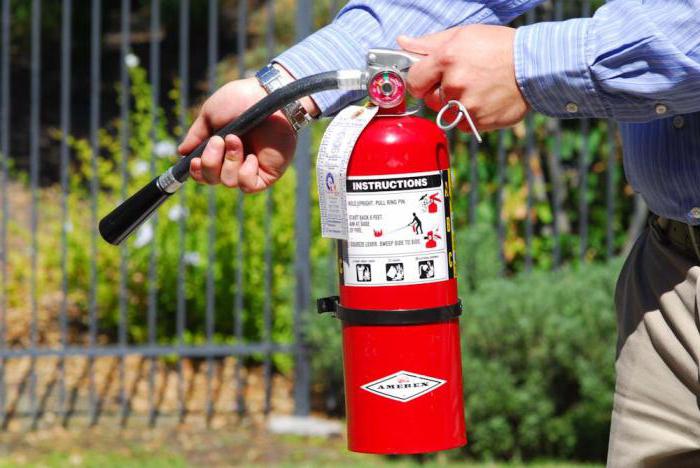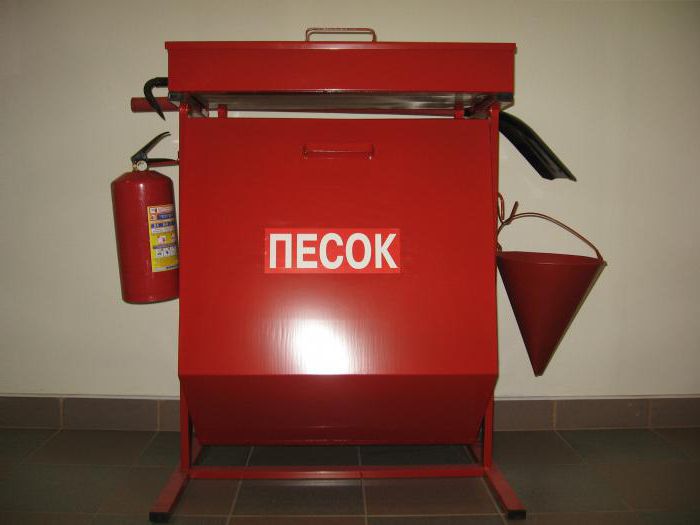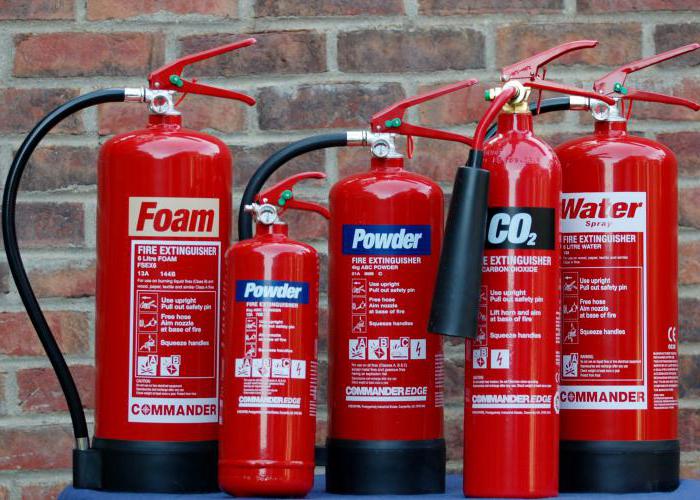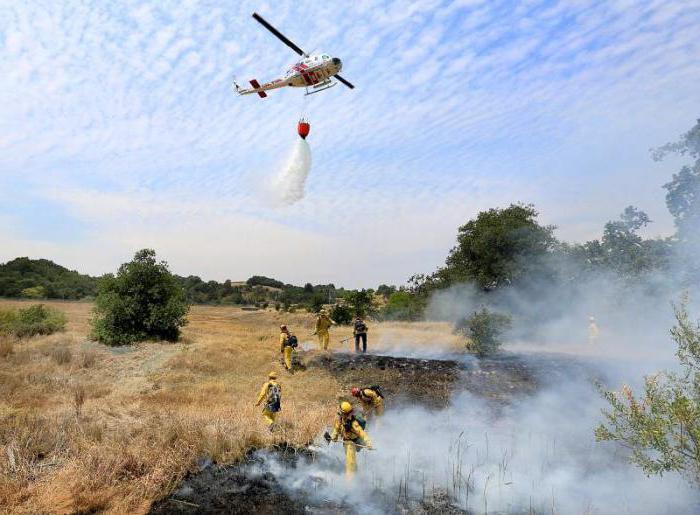Fire is an unpredictable phenomenon that can occur at any time. Its consequences are terrible for the life and health of people. It is frightening that there are no absolutely safe places that would be protected from fire. In this regard, stringent requirements have been established for observing fire safety rules and equipping buildings for any purpose with fire extinguishing means. To cope with the elements of fire, you should have specific knowledge about its properties and methods of elimination, as well as know what fire fighting means exist. Classification and their application will be considered in the article.
General characteristics and varieties
The fire fighting equipment of modern civilization is diverse. It is presented by models for professional extinguishing of large areas of fire, automatic installations for dealing with a fire that has just begun, and also primary tools that are easy to use. It is worth characterizing them, dividing into groups, depending on the design and scope.

The classification of fire extinguishing equipment according to the principle of their placement is as follows:
- Mobile are used for professional fire fighting. This method is based on the use by specialists of vehicles (helicopters, ships, cars). Their action is aimed at supplying water or the substance that is used to extinguish, under pressure to the ignition site.
- Semi-stationary ones allow you to extinguish a fire, moving around the territory for insignificant distances.
- Fixed - pipelines filled with water, foam or steam, responsive to room temperature. Such installations work in automatic or manual mode. After they are started, the pumps are turned on, which supply the substance to extinguish the fire. They are usually installed on ships, in production halls and shopping and entertainment centers.
- Primary - means to combat small fires and just started a fire. They are mobile and easy to use.
Extinguishing media, classification and their application should be studied in the framework of safety precautions by each employee of the enterprise, regardless of its focus.
How to extinguish the flame?
The simplest means to extinguish a fire is water. This is an affordable method that allows you to lower the flame temperature and thus reduce the source of ignition. Water is the first thing that comes to mind in a critical situation. However, do not forget that it is not compatible with all types of fires. It can not be used for chemicals of high density (gasoline, toluene, kerosene), as well as to eliminate electric fire. When extinguishing any chemicals, it is worth considering the fact that water can react with some alkalis, resulting in the formation of toxic and explosive gases. That is why fire extinguishing agents, classification and their application should be especially carefully studied by workers in the industrial sector.
For professional extinguishing fires that arise in enclosed spaces up to 500 cubic meters in volume, the use of water vapor will be an effective way. Within a short time, the room is completely filled with it, the temperature inside is heated to 85 degrees Celsius.This helps to reduce the concentration of oxygen in the air, which directly controls the intensity of the flame. The combustion process is inhibited, and the flame dies out pretty quickly.

Primary fire extinguishing agents along with mobile equipment can be filled with air-mechanical foam, which is used to extinguish solid materials and combustible liquids. It consists of water, air (90%) and a surfactant - foaming agent. The contents of the extinguishing media may also consist of foam generator powder, which contributes to the formation of chemical foam, which inhibits combustion processes.
When extinguishing fires, they often use flue gases, carbon dioxide or nitrogen. They act like water vapor, reducing the concentration of oxygen in the air, depriving the fire of the source of the continuation of the combustion process.
Characteristics of specialized extinguishing media
Mobile fire extinguishing installations are designed to deal with small and large fires in any conditions. They provide specialists with the movement and supply of matter from different distances. The main amount of specialized means consists of transport: cars, trains, helicopters, ships. Their design is based on the use of a motor pump, consisting of an engine and a pump, which allow the liquid to be supplied from the tank to hoses or spray guns aimed at the fire. Modern fire extinguishing installations allow you to transport additional equipment, as well as the personnel of the fire station. Cars are usually used to prevent fires in the city, and helicopters are used for major incidents.
Fire trains are used to eliminate fires and fight fire near railways and are mainly used to extinguish fires due to accidents or natural disasters. Helicopters do an excellent job of global fires. They are widely used during periods of forest fires or in any major incidents. The vessel is used in cases of ignition of other water transport or industrial installations.
Primary extinguishing media: classification and their application
Primary are special devices, tools or materials that are used to eliminate the initial stage of ignition. These devices are most likely to be called fire extinguishing agents, since they are able to cope with the flame, but cannot extinguish the fire that has arisen. They are created to prevent fire and the primary fight against fire. With their help, anyone can cope with the situation, at least a little knowledge of the principle of device and use. If it was not possible to prevent a fire, and the fire does not go out, you should immediately leave the room and give up attempts to combat it. Immediately you need to call the appropriate service. Fire can not be eliminated by people without special equipment and training.

Primary fire extinguishing agents can be found in any building. They are located in a conspicuous place, and the staff is instructed and clearly knows how to use them in an emergency. The fire arsenal of “improvised” means consists of:
- fire extinguishers;
- inventory (shovel, hooks, crowbars, axes);
- sand, nightmares;
- water containers;
- fire hydrants.
The necessary extinguishing media are located in special cabinets, bedside tables or drawers. They are usually painted red to make them easy to find. The contents of the cabinets are formed depending on the classification of devices and their type. The location of the primary fire extinguishing means is selected based on their availability and possible area of fire.
Operation of a fire crane
Fire-fighting crane is one of the simplest methods of effective fire fighting during fire fighting. The security measure is used in rooms of various purposes: from residential and domestic to industrial and household.The device, in fact, provides a water supply with the ability to adjust the magnitude of its flow and jet power. This is a kind of connecting link between the fire hydrant or the water supply network and the room.
Many requirements and installation standards have been created that govern the placement of cranes, operating rules and scheduled inspections. The fire hydrant is activated by two people: one holds the sleeve and the other opens the valve. All elements of the connection and configuration should be of the same type and should be freely actuated.

It is recommended that the fire hose be kept dry. It should be folded in the form of an accordion or double rolling. It is unacceptable to use a fire crane to provide household and household needs. They are placed in special cabinets, built-in or wall-mounted, having openings for ventilation, as well as inspection and sealing without opening. On the cabinet door is indicated the letter index "PC", the number of the crane and the telephone number of the fire service and security.
Testing of fire extinguishing means in the form of a fire hydrant is performed at least once every six months by visual inspection and putting it into working condition to evaluate its performance.
Sand and materials
A common method of fighting fire after water is sand. It is inexpensive, easy to store and use. Sand is used to effectively extinguish oils, liquid combustible substances or to eliminate small foci of ignition of solid materials. Despite the ease of use and purchase, fire-fighting equipment of this type must be stored in certain conditions in compliance with the requirements, including:
- placement in boxes with a volume of 0.5-3 cubic meters with a wide lid, providing free access to the contents;
- installation of containers in places inaccessible to moisture;
- checking the suitability of the material 2 times a year.
When extinguishing flammable liquids, sand should not be poured onto the burning area (it will be sprayed), but along the boundaries of the fire. Fire fighting equipment (shovel, buckets) is located along with sand in a fire shield.
Protect fire extinguishing media, as well as cope with small fires, can be done with the help of a nightmare, felt or asbestos cloth. The area of such materials should be meter per meter, and they themselves are impregnated with flame retardants. The canvases are stored rolled up in metal boxes, inaccessible to moisture.
Auxiliary tools
When fighting fire, you may need additional tools that are located in accessible places indoors. These are peculiar hinged or built-in cabinets, the contents of which are clearly visible - fire shields. In addition to useful items, they contain information on the telephone numbers of the fire service and security departments, an inventory of the contents, the data of the person responsible for the operation and the serial number of the shield with the index “ПЩ”. Usually they contain fire fighting equipment for extinguishing with water and sand (buckets, shovels), as well as tools for separating burning structures or opening the premises: axes, crowbars, hooks.

Cabinet doors or other closing elements are sealed, but so that they can easily be opened in an emergency. When installing any equipment and fire fighting equipment, it must be remembered that the requirements for fire extinguishing means primarily relate to their availability.
Fire extinguishers
What applies to fire extinguishing agents of a universal type? Of course - fire extinguishers. For their storage does not require much space, and the application is not very difficult. They contain substances that contribute to the extinguishing of various types of ignition. In an emergency, it will not be necessary to recall whether it is worth watering the hearth or sprinkling with sand, will this only make it worse.A suitable type of fire extinguisher will also help with electric fires, extinguishing solid materials, metals and liquids of various origins.
The composition is distinguished:
- Carbon dioxide (OU) - a fire extinguisher that is sparing for inventory and equipment, an excellent dielectric, which allows you to extinguish installations with a voltage of up to 1 kV. But you should understand its principle of action: it reduces the concentration of oxygen in the air, which can lead to loss of consciousness of people in the room. The temperature of the outlet bell during application decreases to –60 degrees Celsius, which can lead to frostbite.
- Powder (OP) is a fire extinguisher with a toxic effect for humans, it must be used only behind itself on the way to the exit or evacuation passages. It is impossible to pass in places of a cloud of powder, as it instantly clogs a person’s eyes and respiratory tract. In a confined space, it is used only with personal protective equipment. Allowed to extinguish equipment under voltage up to 1 kV.
- Air-foamy (OPV) - not applicable for extinguishing electrical appliances and substances whose density is higher than water, some alkalis and chemical compounds.

The use of primary fire extinguishing agents in the form of a fire extinguisher may vary slightly. However, the general principle of action is usually similar:
- Remove the seal and remove the safety pin.
- Provide access to the button or arm of the fire extinguisher.
- Direct a stream of material at the source of ignition with a hose or socket nozzle.
Cylinders are located in prominent and accessible places nearby with emergency exits at a height of not more than 1.5 meters from the floor. Authorized fire extinguishers have part numbers, tags and markings on the case, and are sealed. The use of the cylinder or damage to the seal should be followed by the direction of the fire extinguisher for maintenance in order to check serviceability and recharge.
Automatic fire extinguishing
Automatic installations are a universal method of preventing fire and warning about the event of people in the room. The equipment detects the first signs of fire and gives an emergency signal to the fire alarm panel. APS systems (automatic fire alarms) respond to smoke or a rise in temperature and operate around the clock. When a threat is detected, automatic fire fighting is activated by spraying or supplying substances in the form of a liquid, foam or gas. The installation of one or another type of APS is made depending on the location of the system and the nature of the alleged threat.
APS requires monthly testing and scheduled preventive diagnostic and repair work. Regular maintenance of the APS is the key to its proper functioning and safety.
Primary fire extinguishing controls
The procedure for the placement, quantity and use of means to combat fire and small fires is regulated by a number of regulatory documents (FZ-315, FZ-123, NPB 110-03, SNiP 21-01-97, GOST). The fire safety engineer is responsible for organizing, monitoring and using the tools. The main document containing the rules for using fire extinguishing means and their storage is the fire safety instruction of the same name. An engineer develops instructions and trains personnel according to them, maintains a fire safety logbook, and inspects fire extinguishing means.

The developed fire extinguishing algorithm allows you to effectively cope with fires and ensure safety for people nearby. The abundance of technical fire extinguishing means provides any room with the necessary equipment for the primary fight against the flame.Fire prevention is the work of specialists with the use of more serious equipment, so if you cannot manage the fire with improvised means, you should think about your own safety and hand over the matter to professionals.








